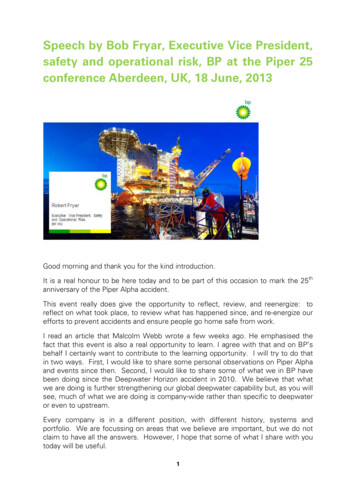
Transcription
Speech by Bob Fryar, Executive Vice President,safety and operational risk, BP at the Piper 25conference Aberdeen, UK, 18 June, 2013Good morning and thank you for the kind introduction.It is a real honour to be here today and to be part of this occasion to mark the 25thanniversary of the Piper Alpha accident.This event really does give the opportunity to reflect, review, and reenergize: toreflect on what took place, to review what has happened since, and re-energize ourefforts to prevent accidents and ensure people go home safe from work.I read an article that Malcolm Webb wrote a few weeks ago. He emphasised thefact that this event is also a real opportunity to learn. I agree with that and on BP’sbehalf I certainly want to contribute to the learning opportunity. I will try to do thatin two ways. First, I would like to share some personal observations on Piper Alphaand events since then. Second, I would like to share some of what we in BP havebeen doing since the Deepwater Horizon accident in 2010. We believe that whatwe are doing is further strengthening our global deepwater capability but, as you willsee, much of what we are doing is company-wide rather than specific to deepwateror even to upstream.Every company is in a different position, with different history, systems andportfolio. We are focussing on areas that we believe are important, but we do notclaim to have all the answers. However, I hope that some of what I share with youtoday will be useful.1
2
I thought I would start with just a few of my own reflections on Piper Alpha.When this accident happened, I was still very new to the industry. I had only workedin it for a couple of years. As for most people, the thing that stood out to me withgreat sadness was the loss of life and the impact that the accident had on so manyfamilies and communities.It also tragically reinforced the fact that we work in a hazardous industry. Our task isto bring energy to people around the world. That task is full of hazards and risks thatmust be understood and managed at all times.Since that time I have worked in operations for most of my career, and I havetherefore been able to see and be part of the industry’s response to this incident. Ihave worked in BP’s North America Gas business, the deepwater Gulf of Mexicoteam, in Trinidad and Tobago, in deepwater Angola. In all of those businesses, Ihave felt the positive response to Piper Alpha.This shows up in changes in the way work is controlled, how engineering is used toprevent fires and explosions, and many other areas.The response from industry and government was very effective. Lord Cullenproduced a landmark report and the accident acted as a real catalyst for change.Despite all of these improvements, the fact is that in general the hazards and riskshaven’t changed. They are still there. What changes is the way we relate to thosehazards and risks as we learn and improve over time.3
And when you look at lost time frequency in the UK offshore over the last 25 years,there has been real improvement.From looking at the results, three things jump out for me.First, while I recognise we are only looking at one metric, continuous improvementseems to have occurred over the last 25 years. Rarely do you see a subsequent yearfrequency exceed the preceding year. This improvement has substantially reducedthe number of people being hurt, which is a goal we all share.The second thing that you can see from the data is that there are some changes inthe slope of the line. Where there have been big reductions in the lost time injuryfrequency, many times this is associated with a particular event.The Step Change in Safety campaign, for example, was launched in 1997 and wasan effort to refocus the industry. They set an ambitious target of a 50%improvement in the safety performance of the industry in the UK over the next 3years. I believe it made a real difference.Like the Piper Alpha accident and the Cullen report, Step Change in Safety served asa driver to make real safety improvements in a relatively short period of time. Theseexamples show that industry-wide effort and commitment can take us forward. Andthe good news is that these improvements have been sustainable.However, the third thing that you can see from the data is that for the last severalyears, we are in a flat spot.As Malcolm has observed, the purpose of the time spent together this week shouldbe to re-energize ourselves and the industry to make a fresh effort to reduce stillfurther the safety and environmental risks associated with the possibility of a major4
accident in our industry. And the flattening out of the data suggests that this is agood time to be making that renewed commitment.We all have our own personal reasons for making that commitment afresh. One ofmine is that my eldest son will start his first job in this industry in two weeks’ time.But also, as for others in BP and across the industry, it is the memory of friends andcolleagues lost in tragic accidents such as Piper Alpha and Deepwater Horizon. Anda determination to do everything in our power to avoid further loss of life andenvironmental damage.Today is primarily about remembering Piper Alpha, but, when we review progresssince 1988, it is inevitable that people will focus on the accident we and othersexperienced three years ago, Deepwater Horizon.5
So let me briefly look back to 20 April 2010. That was the day when the DeepwaterHorizon rig experienced a blowout as its crew was working on the temporaryabandonment of the Macondo well. 126 people were on board.Hydrocarbons escaped from the well resulting in explosions and a fire that burnedfor two days until the rig sank.Tragically, 11 men lost their lives and others were injured. Hydrocarbons continuedto flow from the well for 87 days.We deeply regret our role in this accident. Several organizations have conductedinvestigations and published reports. These include our own BP investigation andthe report of the President’s National Commission. All official reports and our owninternal investigation concluded that the accident was the result of multiple causes,involving multiple parties.Several factors stand out in the findings of these reports.The cement at the bottom of the well did not seal off the hydrocarbons in theformation.The negative pressure test carried out to check that the well was sealed wasmisinterpreted.And the blow-out preventer did not seal the well at the seabed. It is clear that theblind shear rams failed to seal.6
Before I look at what we’re doing across the company, let me say a few wordsabout the response to the oil spill itself.Our intention in the response was to step up and do what was right – going wellbeyond the statutory legal obligations - so we put a huge amount of resource into it.It was a complex and massive undertaking. Plugging the leak meant working withrobot submarines to apply containment equipment to a high pressure well a milebelow the ocean. No one had done that before.Cleaning up the spill meant a huge effort with thousands of people and vessels aswell as airplanes and the largest deployment of boom ever – approximately 13.5million feet.At the time, I was running our deepwater business in Angola and I was one of manyleaders from around BP who flew to the Gulf. I spent 4 months working on theresponse, and I will always remember the dedication of the people and theresponse of the industry and community as well as our own company.When I arrived, shortly after the accident occurred, my first task was to call othercompanies to seek their help. I remember making phone calls in the morning, and,by the afternoon, we had experts from Anadarko, Shell, Exxon and others in theoffice helping us. Additionally, other companies called and asked how they couldhelp. BP deeply appreciates how people offered their assistance, and the differencethey made.And as I mentioned earlier, the experience generated a deep desire across the teamto learn from the accident and to seek to prevent the repetition of such a tragedy.7
I also want to mention the community’s part in the response. The majority of thepeople who took part in the response came from the local community. I grew up inLouisiana and have lived on the Gulf Coast for almost 40 years. I am really proud tosay that I am from the community that responded in the ways that folks from theGulf Coast did.Because of the accident, a number of these folks and businesses were affected.And we have committed to compensate folks who suffered damages resulting fromthe spill. As well as spending more than 14 billion in operational response andclean-up costs, BP has paid more than 10 billion in claims, settlements and otherpayments.8
I would like to turn now to talk more broadly about the areas that we are focusing onacross the company. As I said before, we do not claim to have all the answers, but Ihope that some of this may be useful.First I will talk about our work on deepwater capability in wells, notably onimplementing the recommendations from the Bly report.Then I will go on to talk about what we are doing company-wide, with an emphasison systematic operating which we believe also benefits our global deepwateroperations.9
Following the accident, Mark Bly, who was my predecessor as Head of the Safetyand Operational Risk function, led the BP internal investigation of the accident,which was conducted by a team including internal and external expertise.The resulting Bly Report included 26 recommendations addressing important areasof deepwater drilling, including cementing guidelines, equipment certification,assuring the competence of individuals, and testing of blow-out preventers.The recommendations directly addressed the findings of the investigation. Forexample, they recommend a review of all cementing contractors and newmandatory practices for cementing.They recommended revising the relevant BP engineering technical practice toinclude more details on negative pressure tests, including areas such as successcriteria, responsibilities of personnel and configuration of valve positions.With regard to blow-out preventers, the recommendations contained new provisionson maintenance, testing and design.The implementation of these recommendations is an ongoing major programme ofwork within BP. Each recommendation has to be applied across multiple locations –and many require new processes or agreements with contractors.We have broken down each of the recommendations into defined and measurabledeliverable actions. The closure of the recommendations is verified by our Safetyand Operational Risk audit team, which worked with the Bly report program team tomake sure that the deliverables flowing from the recommendations would beverifiable. Closure is also verified by an independent expert who was appointed byBP’s Board of Directors in June 2012.Fourteen of the 26 recommendations are now complete.10
As well as implementing the recommendations of the report, we have also taken anumber of broader measures to further support safety and risk management in ourupstream organisation.One of the first things that we did was to look at the organisation itself. We wantedour upstream organization to be structured in a way that would encourage thebuilding of capability and the consistent application of standards across the world,wherever they apply.We did this by moving from an asset model to a functional model. What does thatmean? It means that, instead of organizing the company in regional teams, weorganized our upstream in centralized functions that bring together the people whodo the same jobs around the world. All the explorers report to the head ofexploration. All the people who build new projects report to the head of the GlobalProjects Organization. The people involved in drilling, completions and interventionsall report to the head of the Global Wells Organization.A benefit of this is that we can build on our expertise within the teams to deliverexcellence in each function and also drive standardization more readily where wewish to do so, with each team using standard procedures. We believe theseprocedures contribute to consistent implementation and safer execution of work.We also have looked at capability development within the framework of the newfunctional organisations. Part of this is about technical specialist capability. In ourglobal wells organisation, we have brought deep expertise in house. We now have12 cementing specialists in the company, as well as the cementing contractors wework with. We also have a team of 30 dedicated solely to BOP reliability.But maintaining and enhancing capability is also about training. We have set up theGlobal Wells Institute, which brings all our Wells training under one roof. The11
institute emphasises practical, experiential learning and a big part of that learningoccurs in the state of the art well simulator area which we have commissioned. Thesimulators are used by BP personnel as well as by the contractors who actually drillthe wells and who ultimately are responsible for well control. I’m told that the roomcontains the world's largest collection of drilling simulators in one space. Thesimulators replicate three major operations: the offshore environment, land-baseddrilling, and workovers. This simulator allows for the observation and assessment ofindividuals as they manage hypothetical well control incident scenarios.12
Of course, plant and equipment is also important. As well as introducing this newkit for training, we have also taken action with regard to the equipment andtechnology we use in actual deepwater drilling.We have reviewed our requirements for drilling rigs in service on BP-operated wells.Any proposed departures from those requirements need approval from theappropriate person in our Safety & Operational Risk organisation – what we callS&OR. I’ll be saying a little more about S&OR shortly.But we are mindful that technology, plant and equipment can serve us in manyways. Strengthening deepwater capability is not all about the kit that actually doesthe drilling. We have also set out to use technology to enhance our integrateddecision-making on drilling and wells.In Houston we have created a Monitoring Center that enables offshore crews toconsult in real time with onshore experts – viewing the same data and linked byvideo. While the responsibility for well monitoring remains with the rig crew, havinga monitoring center means more people can be available as resources in a givencircumstance. We believe this can lead to more considered decisions by those whohave ultimate accountability. And, of course, I should be clear that accountability forthe final decision will always remain with the rig crew – the Monitoring Center isabout informed decisions, not collective decisions.13
Obviously our top priority is to prevent accidents but part of building deepwatercapability is to be prepared for the worst. Since 2010 there has been a strongindustry-wide programme of activity in the area of spill response.At the international level, the Global Industry Response Group was set up and haslaunched several work-streams. One is looking at data from incidents andcommunicating good practice, so the entire industry can learn together. Anotherrelates to developing a well capping toolbox. Another is focused on response ingeneral – capturing the lessons we learned in areas such as relief well drilling andcrisis management.BP has built its own capping stack and other containment equipment. It is stored inHouston but can be mobilised worldwide quickly.Here in Britain, Oil & Gas UK has taken the lead and worked with the Oil SpillPrevention and Response Advisory Group to develop a response toolkit that includesa capping device. So we are seeing a number of these devices positioned aroundthe world.14
So hopefully that has given some flavour of how we have responded to theDeepwater Horizon accident across our global wells organisation.We want to operate systematically everywhere, not just in deepwater, but onshore,downstream and in all parts of our business.So I would like to share with you briefly how we are systematically approachingsafety and operational risk at the company level. I believe these initiatives aremaking an important contribution to the safety of our deepwater operations.15
Following the Deepwater Horizon accident, we established a Safety and OperationalRisk organization – “S&OR”. As I mentioned, Mark Bly initially headed theorganization and I have recently taken over from Mark.The S&OR organization helps us provide an expert view of safety and risk that isindependent of the business and its line management.The S&OR team is made up of hundreds of professionals whose focus is on safetyand operational risk. Many of these professionals are based around the worldalongside our operating businesses. For example, we have an independent S&ORteam right here in Aberdeen - not part of our North Sea business, but part of theS&OR organisation that I lead.I should stress that the existence of S&OR does not absolve the line managers ofresponsibility for safety and operational risk. Indeed we make it crystal clear thatthe line is accountable for safety. The people who do the work must shoulder thataccountability but we – S&OR – are here to help them manage the risks effectivelyand to conduct risk-based assurance. Yes, and to challenge them where necessary.The organization has very clear roles: setting clear Safety and Operational Risk requirementsmaintaining its independent view of risk – in particular by conductingassurance and audits on the work of the line organizationproviding deep technical expertise. This includes expertise in engineering,security, safety (both personal safety and process safety), health and theenvironment; and, if necessary, intervening to cause corrective action basedon our independent view.16
We believe that systematic operating is the foundation of a safe and strong BP – itdrives both efficiency and safety, and therefore long-term value – a safe business isa successful business.We’ve been taking action to implement three enduring principles which, we believe,together add to a framework for safe, reliable and efficient operations. Under theseprinciples, we are pursuing five specific areas of focus that relate to them and whichdictate our programmes of work and activity.The first is about people – further deepening capabilities and maintaining a strongfocus on safety; this very much includes the nature of leadership. So buildingorganisational capability across BP and strengthening leadership and culture are twospecific focus areas for us.The second principle is about the actual system we use to drive systematicoperating and to manage safety and operational risk - called our operatingmanagement system or OMS. So continuing to embed OMS and to enhance riskmanagement are two further focus areas for us.The third principle is about what we call assurance – essentially assuring ourselvesas to whether capabilities are present and OMS is working to continuouslystrengthen our operations. This includes collating data (measurement andassessment) – and also inspecting, auditing, and checking. These are layers ofassurance or ‘checks and balances’. So this gives us a fifth focus area strengthening our checks and balances. As you’ll see, our global S&OR organisationhas a key role to play in this area,Let me tell you a little about each of these principles and some of what we’re doingunder each of them at the company level.17
Our CEO Bob Dudley has been really clear in his expectations of the company withrespect to safety – that safety lies at the heart of BP and at the heart of goodbusiness. He has also been clear that he expects leaders to spend time in the fieldand maintain great sensitivity to risk.In the last three years we have introduced several measures to further support andtrain our leaders.I’ll
Speech by Bob Fryar, Executive Vice President, safety and operational risk, BP at the Piper 25 conference Aberdeen, UK, 18 June, 2013 . Good morning and thank you for the kind introduction. It is a real hon
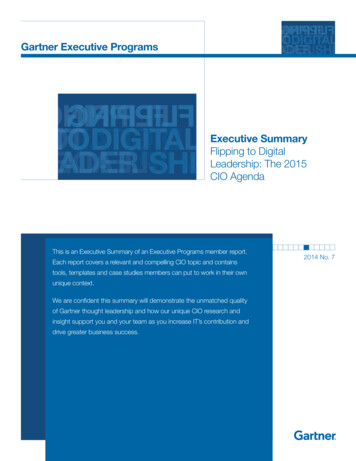
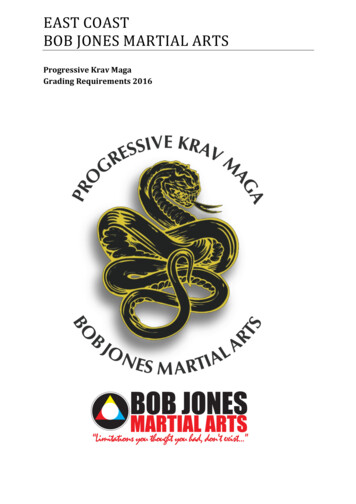
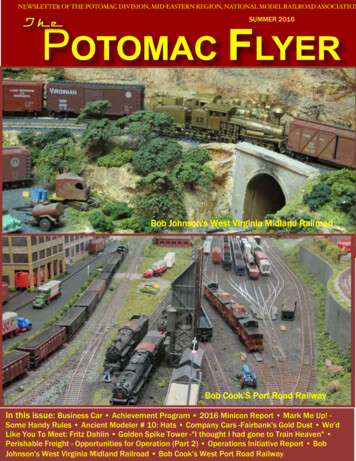
![[EPUB ] The Bob's Burgers Burger Book: Real .](/img/6/the-bob-039-s-burgers-burger-book-real-recipes-for-joke-burgers.jpg)
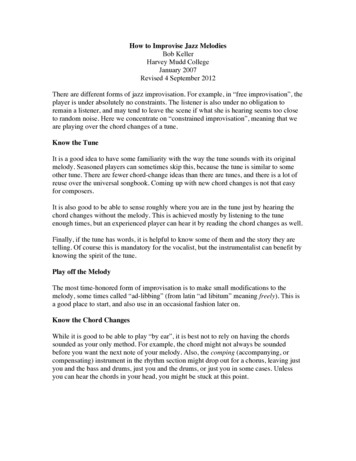

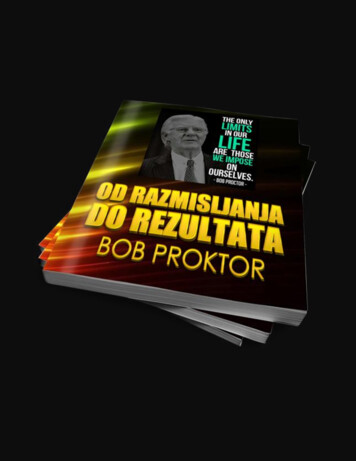

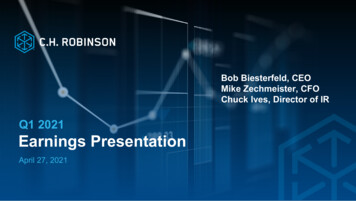
![[OFF CAMERA COMMENTS] BOB PROCTOR - ABC News](/img/13/microsoft-20word-20-20proctor-20transcript.jpg)

